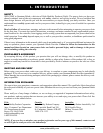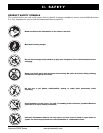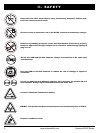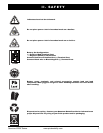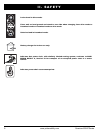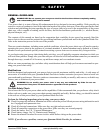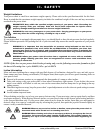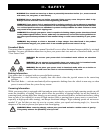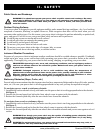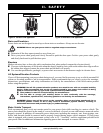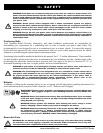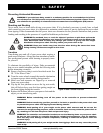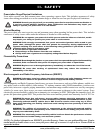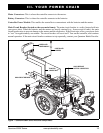
12 www.pridemobility.com Quantum 6000Z Series
II. SAFETY
Public Streets and Roadways
WARNING! You should not operate your power chair on public streets and roadways. Be aware
that it may be difficult for traffic to see you when you are seated on your power chair. Obey all
local pedestrian traffic rules. Wait until your path is clear of traffic, and then proceed with
extreme caution.
Outdoor Driving Surfaces
Your power chair is designed to provide optimum stability under normal driving conditions—dry, level surfaces
composed of concrete, blacktop, or asphalt. However, Pride recognizes that there will be times when you will
encounter other surface types. For this reason, your power chair is designed to perform admirably on packed soil,
grass, and gravel. Feel free to use your power chair safely on lawns and in park areas.
Avoid driving on uneven terrain and/or soft surfaces.
Avoid tall grass that can entangle the running gear.
Avoid loosely packed gravel and sand.
Do not use your power chair in fresh or salt water.
Do not use your power chair at the edge of a stream, lake, or ocean.
If you feel unsure about a driving surface, avoid that surface.
Inclement Weather Precautions
Exposure of your power chair to inclement weather conditions should be avoided whenever possible. If suddenly
caught up in rain, snow, severe cold or heat while operating your power chair, proceed to shelter at the earliest
opportunity. Thoroughly dry your power chair before storing, charging, or operating your power chair.
PROHIBITED! Operating in rain, snow, salt, mist/spray conditions, and on icy/slippery surfaces
can have an adverse effect on the electrical system. Maintain and store your power chair in a
dry and clean condition.
WARNING! Prolonged exposure to hot or cold conditions may affect the temperature of
upholstered and non-upholstered items on the power chair, possibly resulting in skin irritation.
Exercise caution when using the power chair in extremely hot or cold conditions or when
exposing your power chair to direct sunlight for prolonged periods of time.
Stationary Obstacles (Steps, Curbs, etc.)
Proceed with extreme caution when driving near raised surfaces, unprotected ledges and/or drop-offs (curbs, porches,
stairs, etc.). Be sure your power chair is traveling perpendicular to any curb you may be required to navigate.
To navigate up over a curb or stationary obstacle:
1. Approach the curb or obstacle slowly, and make sure the power chair is traveling perpendicular to the obstacle.
See figure 2.
2. Increase the forward spped just before the front wheels come in contact with the obstacle.
3. Reduce the forward speed only after the rear wheels have cleared the obstacle.
To navigate down a curb or stationary object:
1. Approach the curb or obstacle slowly, and make sure the power chair is travleing perpendicular to the obstacle.
See figure 2.
2. Reduce the forward speed just before the front wheels come in contact with the obstacle.
3. Increase the forward speed only after the rear wheels have cleared the obstacle and you are once again on a level
surface.
WARNING! Even though your power chair may be capable of handling greater obstacles, Pride
recommends that you do not attempt to negotiate a curb that is higher than 2 in. (5 cm). Doing
so could cause instability in your power chair.
WARNING! Do not attempt to have your power chair proceed backward down any step, curb, or
other obstacle. This may cause the power chair to tip.



